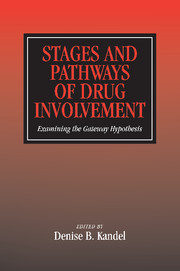Book contents
- Frontmatter
- Contents
- List of Contributors
- Foreword
- Preface
- Part I Overview
- Part II Recent Substantive Findings: What Do We Know About Stages of Drug Use, Risks, and Protective Factors?
- 2 Drug Sequences, Age of Onset, and Use Trajectories as Predictors of Drug Abuse/Dependence in Young Adulthood
- 3 Substance Use Norms and Transitions in Substance Use: Implications for the Gateway Hypothesis
- 4 Stages of Drug Involvement in the U.S. Population
- 5 Substance Use Progression and Hard Drug Use in Inner-City New York
- Part III Impact of Prevention Interventions: A Test of the Progression Hypothesis
- Part IV Methodological Issues and Approaches: Advantages and Limitations of Alternate Methods
- Part V Animal Models and Biological Processes: Implications for Drug Progression
- Part VI Conclusion
- Index
2 - Drug Sequences, Age of Onset, and Use Trajectories as Predictors of Drug Abuse/Dependence in Young Adulthood
Published online by Cambridge University Press: 25 July 2009
- Frontmatter
- Contents
- List of Contributors
- Foreword
- Preface
- Part I Overview
- Part II Recent Substantive Findings: What Do We Know About Stages of Drug Use, Risks, and Protective Factors?
- 2 Drug Sequences, Age of Onset, and Use Trajectories as Predictors of Drug Abuse/Dependence in Young Adulthood
- 3 Substance Use Norms and Transitions in Substance Use: Implications for the Gateway Hypothesis
- 4 Stages of Drug Involvement in the U.S. Population
- 5 Substance Use Progression and Hard Drug Use in Inner-City New York
- Part III Impact of Prevention Interventions: A Test of the Progression Hypothesis
- Part IV Methodological Issues and Approaches: Advantages and Limitations of Alternate Methods
- Part V Animal Models and Biological Processes: Implications for Drug Progression
- Part VI Conclusion
- Index
Summary
According to Wohlwill (1973), developmental trajectories can be described in terms of a variety of parameters indicating presence of change; direction of change; shape of trajectory; values of maxima, minima, or terminal levels; sequencing of events; timing of events; and/or age corresponding to specified values of any of those characteristics. The sheer number of possible parameters serves as a reminder that whichever one is used in empirical studies can only provide a very incomplete picture of individual differences in developmental trajectories. The empirical study of such parameters can be aimed at two somewhat different objectives. First, researchers may be interested in identifying the factors and mechanisms that produce individual differences in a parameter of interest. Second, it is also desirable and useful to examine whether differences in a given parameter predict differences in relevant developmental outcomes at a later point in time. In this chapter, we are primarily concerned with the second objective. Ideally, the two approaches complement each other by focusing on the same or similar parameters. Unfortunately, however, theories of substance abuse and dependence provide little guidance as to which of the many available parameters are more or less useful for an understanding of the development of abuse and dependence in young adulthood.
- Type
- Chapter
- Information
- Stages and Pathways of Drug InvolvementExamining the Gateway Hypothesis, pp. 19 - 41Publisher: Cambridge University PressPrint publication year: 2002
- 36
- Cited by



